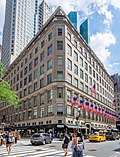Search results
Appearance
There is a page named "18 East 50th Street" on Wikipedia
- 30 East 51st Street)Olympic Tower, 11 East 51st Street, and 488 Madison Avenue to the northwest; St. Patrick's Cathedral to the west; and 18 East 50th Street and the Swiss Bank...107 KB (10,049 words) - 03:23, 19 June 2024ten of its floors. The building is abutted by 18 East 50th Street to the east. It is across 50th Street from St. Patrick's Cathedral and across Fifth...64 KB (6,550 words) - 02:23, 19 June 2024occupies a city block bounded by Fifth Avenue, Madison Avenue, 50th Street, and 51st Street, directly across from Rockefeller Center. Designed by James Renwick...168 KB (17,729 words) - 12:47, 3 May 2024
- 125 East 50th Street)(formerly the Beverly Hotel and Benjamin Hotel) is a hotel at 125 East 50th Street, at the northeast corner with Lexington Avenue, in the Midtown Manhattan...67 KB (6,511 words) - 19:00, 30 June 2024
- 130 West 42nd Street)previously been built in Manhattan, such as the Hampton Shops Building on 18 East 50th Street, none had as wide a scope as the planned Bush Terminal Exhibition...73 KB (7,656 words) - 01:23, 19 June 2024
- original on 6 February 2010. Retrieved 16 February 2011. "EastEnders to celebrate Coronation Street 50th with on screen mention". Beehive City. Honeycomb Publishing...155 KB (17,084 words) - 19:24, 28 June 2024
- 214 numbered east–west streets ranging from 1st to 228th, the majority of them designated in the Commissioners' Plan of 1811. These streets do not run exactly...62 KB (7,195 words) - 16:38, 7 June 2024
- Coronation Street were broadcast live. A live episode was produced in December 2000 to celebrate the programme's 40th anniversary. As the show's 50th anniversary...20 KB (2,261 words) - 10:00, 4 March 2024
- in-the-Bowery on 10th Street at Second Avenue. St. Mark's Place is considered a main cultural street for the East Village. Vehicular traffic runs east along both...55 KB (6,482 words) - 19:58, 26 April 2024
- attracted thereto. Captain George Brunswick Smyth, formerly of her Majesty's 50th Regiment, purchased Chelsworth. Mr. David M'Arthur came next to him. Then
- AmazonCrossing, Seattle, September, 2011 Barney Rosset, The Evergreen Review, 50th Anniversary edition, New York, 2010. Michael Somoroff, documentary video
- turn. Get that clearly now? Take a tapping at the 10th, 20th, 30th, 40th, 50th, 60th, 70th, 80th, FIG. 4 90th, 100th, and the last turn, 11 taps in all




